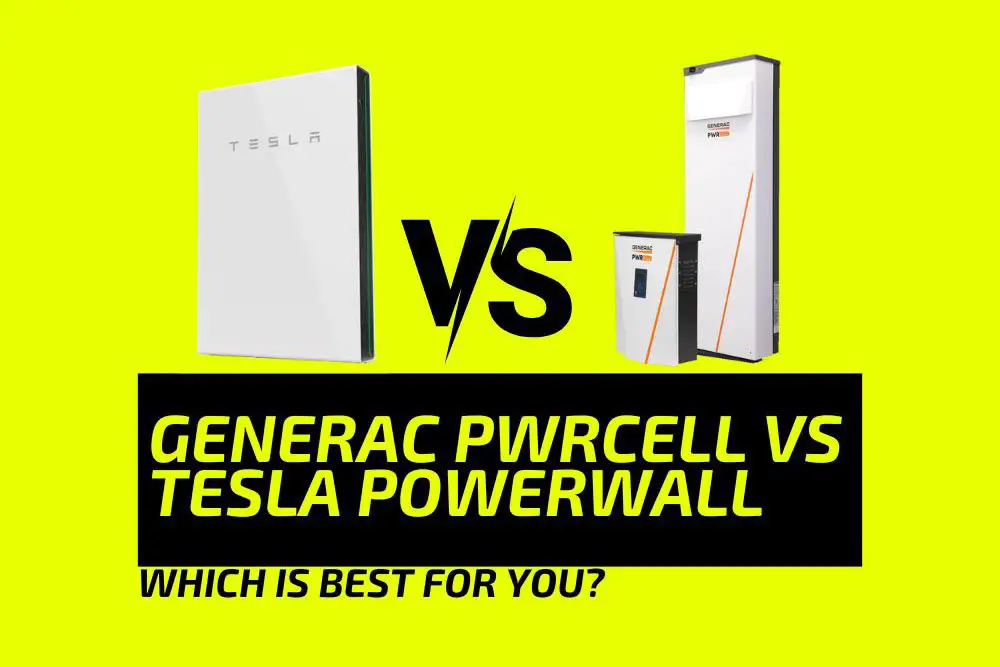Generac PWRcell vs Tesla Powerwall: Which Is Best For You?
If you’re looking to invest in clean energy for your home, you’ve probably come across the idea of adding a battery storage system. You might be considering two popular options: the Generac PWRcell and the Tesla Powerwall. Both battery solutions have advantages and differences, and it’s worthwhile understanding them before deciding.
When comparing the Generac PWRcell and Tesla Powerwall, you should consider factors like efficiency, warranties, and cost. You’ll find that the Generac PWRcell has a 96.5% efficiency, slightly higher than the Tesla Powerwall’s 90% efficiency due to its DC-coupled system, which has two fewer power inversions. In terms of warranties, the Tesla Powerwall offers a decent 10-year warranty with a guaranteed end-of-warranty capacity of 70%.
As for cost, a fully loaded Generac PWRcell cabinet with six battery modules would cost you around $15,000 to $17,000. When you weigh these factors, you’ll be better equipped to choose the right battery storage system for your solar panel setup, ensuring that you’re maximizing the benefits of your solar energy investment.
TLDR Summary
When comparing the Generac PWRcell and Tesla Powerwall, it’s essential to look at efficiency and cost. The PWRcell is a DC-coupled system, which means it has two fewer power inversions than the AC-coupled Tesla Powerwall. This results in the PWRcell being 7-10% more efficient, with an efficiency of 96.5% compared to the Powerwall’s 90%.
Concerning cost, a fully loaded Generac PWRcell cabinet with six battery modules will set you back about $15,000 to $17,000 (as of July 2022). On the other hand, Tesla’s Powerwall comes with a 10-year warranty and a guaranteed end-of-warranty capacity of 70%. Remember that rechargeable batteries will always lose some of their capability to hold the full charge and recharge fully over time.
Some popular alternatives to the Tesla Powerwall include:
- Generac PWRcell
- LG Chem RESU
- Sonnen Eco
- Enphase IQ Battery
Each of these home battery options offers various benefits, and all will help with electricity bill savings and resilience against grid outages.
When deciding on a home battery system, you’ve got to weigh every aspect up, including efficiency, cost, warranty, and alternatives, in order to decide what’s best for you.
Key Differences
When comparing the Generac PWRcell system and Tesla’s Powerwall, it’s essential to consider the efficiency of these energy storage systems. The Generac PWRcell is a DC battery, while Tesla Powerwall uses an AC battery. This means that the Powerwall requires an extra conversion step to store solar energy. As a result, the PWRcell has slightly higher efficiency than the Tesla Powerwall: 96.5% vs. 90%.
Another difference to pay attention to is the capacity of each battery system. The Tesla Powerwall provides 13.5 kWh of usable energy storage, making it suitable for most residential needs. In contrast, the Generac PWRcell offers a range of capacities from 8.6 kWh up to 17.1 kWh. This means you can customize the PWRcell system to fit your specific energy requirements.
Let’s get into the pricing of these two systems. While the exact prices can vary depending on installation factors and local incentives, the Tesla Powerwall is generally considered more affordable. It is priced at around $11,500, including the supporting hardware and installation costs. On the other hand, Generac’s PWRcell has a higher upfront cost and fluctuates depending on the chosen capacity, with an average cost of around $15,000 to $20,000.
Now let’s talk about warranties and system longevity. Tesla offers a 10-year warranty for their Powerwall with a guaranteed minimum 70% capacity retention. Generac provides a similar warranty for the PWRcell, with a 10-year assurance and at least 60% capacity retention. In this aspect, the Tesla Powerwall has a slight edge concerning long-term performance.
To summarize, comparing the key differences between the Generac PWRcell and Tesla Powerwall:
- Efficiency: PWRcell (96.5%) is more efficient than Powerwall (90%)
- Capacity: Powerwall has a fixed capacity (13.5 kWh), while PWRcell is customizable (8.6-17.1 kWh)
- Cost: Powerwall is generally more affordable ($11,500) than PWRcell ($15,000-$20,000)
- Warranty: Both systems offer a 10-year warranty, but Powerwall guarantees higher capacity retention (70% vs. 60%)
These factors should help you evaluate which energy storage system may be the right fit for your specific needs and preferences.
Storage Capacity and Battery Modules
When comparing the Generac PWRcell and the Tesla Powerwall, let’s start by looking at their storage capacities. The PWRcell offers a range of capacities, from 8.6 kWh up to 17.1 kWh, depending on the number of battery modules. The Tesla Powerwall comes with a storage capacity of 13.5 kWh.
Now, let’s focus on battery modules. Generac PWRcell has a modular design, allowing you to customize your energy storage with up to six battery modules. Each module has a 2.85 kWh capacity. This flexibility is great for different household needs and budgets since you can add or remove modules as required.
On the other hand, the Tesla Powerwall comes with a single battery module, which makes it slightly less flexible than the PWRcell. The lithium battery in the Tesla Powerwall offers 13.5 kWh of capacity per unit.
It’s important to know that both the PWRcell and Powerwall use lithium-ion batteries, with the Powerwall using NMC chemistry. Both of these batteries can store a lot of power in a small space as they are quite energy dense. This makes them perfect for home energy storage solutions.
When deciding between these two options, consider factors such as your home’s energy consumption, the size of your solar system, and how much storage capacity you need for emergencies. In the end, this choice will come down to what suits your specific needs and preferences best.
Solar Components and Inverters
When comparing Generac PWRcell and Tesla Powerwall, it is very important to explore their solar components and inverters. Both systems include solar panels, solar battery storage, and solar inverters. Let’s delve into how each system works and what distinguishes them from each other.
Generac PWRcell is a DC battery system built for solar power systems. Its solar inverter, known as the PWRCell inverter, weighs 62.7 pounds and measures 24.5 x 19.25 x 8 inches. Your solar array is connected to this inverter, which efficiently converts solar energy into electricity for direct storage in the battery. PWRcell provides a relatively higher efficiency rate of 96.5% when compared to Tesla Powerwall.
On the other hand, Tesla Powerwall is an AC battery system, giving it an efficiency rate of 90%. This lower efficiency rate is due to an extra conversion step required to store solar energy from your solar panel system. Although the Tesla Powerwall has a lower energy efficiency compared to Generac PWRcell, it still offers seamless integration with your existing solar power system.
Here are some key points for comparing both systems:
- PWRcell offers a higher energy efficiency rate (96.5%) than Tesla Powerwall (90%).
- Both systems incorporate solar arrays, solar batteries, and solar inverters.
- Generac PWRcell is a DC battery system, while Tesla Powerwall is an AC battery system.
Remember, when choosing between the Generac PWRcell and Tesla Powerwall for your solar power system, consider their solar components and inverters since they play a major part in ensuring efficient energy storage and seamless integration with your existing solar array.
Installation and Costs
When comparing the Generac PWRcell and Tesla Powerwall, it’s essential to consider the installation and costs associated with each. The installation process for both systems is similar, with certified technicians handling the job. Let’s dive into the average costs and tax credits for each option.
For the Tesla Powerwall, the cost of a single unit is $6,500, and the supporting hardware adds another $1,100, bringing the total to $7,600. Keep in mind that this doesn’t include installation costs, permit fees, or other expenses. In reality, the total cost of installing a single Powerwall ranges between $14,500 and $16,000.
On the other hand, the Generac PWRcell’s cost varies depending on the configuration. The average price for an installed Generac PWRcell ranges from $13,000 to $19,000.
Now, let’s talk about tax credits. Both the Powerwall and PWRcell qualify for a federal tax credit, which can help offset some of the costs. The federal solar tax credit is quite simple; it will let you deduct 26% of the cost of your solar energy system, including any battery storage, from your federal taxes. Keep in mind that this percentage will decrease to 22% in 2023.
In summary, both the Generac PWRcell and Tesla Powerwall offer reliable energy storage solutions with similar installation processes. While the Tesla Powerwall has a more consistent price range, the Generac PWRcell offers different configurations that may suit your specific needs. Don’t forget to consider the available tax credits when making your decision.
Energy Management and Mobile App
Managing your home energy system can be quite simple, thanks to innovative mobile apps for both the Generac PWRcell and Tesla Powerwall. These easy-to-install apps let you control and monitor your energy usage, making it a breeze to optimize your consumption.
Generac PWRcell
The PWRcell system uses the PWRview app to provide you with real-time information on your energy usage. With PWRview, you can:
- Track your energy consumption habits
- Set goals to minimize usage and reduce costs
- Receive notifications about energy usage, system performance, and maintenance needs
- Access reliable backup power during power outages
Tesla Powerwall
On the other hand, the Tesla Powerwall uses the Tesla mobile app to enable monitoring and control of your energy storage system. This app allows you to:
- Monitor your solar production, battery power, and grid consumption
- Manage your Powerwall settings to optimize backup and energy savings
- View daily and historical energy data
- Access remote control over your Powerwall, adjusting settings to meet your needs
Both systems offer you the convenience and flexibility needed for efficient energy management. Start exploring these powerful tools and enjoy better control over your home energy usage.
Backup Power and Energy Independence
When you’re exploring home battery backup systems, Generac PWRcell and Tesla Powerwall are two top contenders. Both of these systems promote energy independence by storing electricity generated from solar panels or the grid to provide backup power during outages.
PWRcell Overview
With the Generac PWRcell, you’ll benefit from its modularity feature. This means you can customize the battery capacity to suit your energy needs. PWRcell’s storage capacity ranges from 8.6 kWh to 17.1 kWh. Additionally, its DC-coupled design results in 7-10% greater efficiency compared to the Powerwall. This efficiency is achieved by going through two fewer power inversions, ultimately giving you more value for your money. The PWRcell operates at temperatures between 14 and 122°F (-10 to 50°C) and can handle altitudes up to 2000m.
Powerwall Overview
Moving on to the Tesla Powerwall, you’ll find that it has a fixed storage capacity of 13.5 kWh. While this capacity is right in the middle of the PWRcell’s range, keep in mind that it’s not customizable based on your specific energy requirements. Nevertheless, the Powerwall operates at a broader temperature range, from -4 to 122°F (-20 to 50°C), and can work at higher altitudes – up to 3000m.
In terms of performance, some key features to consider are:
- Generac PWRcell: Storage capacity: 8.6 – 17.1 kWh
- Operating temperature: 14 – 122°F (-10 to 50°C)
- Maximum altitude: 2000m
- Tesla Powerwall: Storage capacity: 13.5 kWh
- Operating temperature: -4 to 122°F (-20 to 50°C)
- Maximum altitude: 3000m
Wrap Up!
Comparing the Generac PWRcell and Tesla Powerwall, it’s evident that both batteries have their own strengths and benefits. The Tesla Powerwall has an AC battery system, whereas the Generac PWRcell is a DC-coupled battery.
When thinking about efficiency, the PWRcell has a slight advantage over the Powerwall with 96.5% efficiency, compared to 90%. This means that you might get more energy storage capabilities with the PWRcell. On the other hand, the Powerwall also excels in other areas, such as continuous power output.
Looking at warranties and scalability, both the PWRcell and Powerwall share similarities. They both offer strong warranties and have similar price points. Moreover, scalability is a feature in both, with the capability to link up to 10 Powerwalls together for a larger energy storage solution and PWRcell offering customization options.
Here’s a quick summary of the key aspects to consider:
- Efficiency: PWRcell offers 96.5% efficiency, while the Powerwall has 90% efficiency.
- Maximum Continuous Power: Compare the power output capabilities of each battery system.
- Scalability: Both systems allow for expansion, with the Powerwall supporting up to 10 linked units.
- Warranties and Price: Examine the warranty details and pricing for both systems.
Making a choice between these two energy storage systems ultimately depends on your specific requirements and intended usage. Are you focusing on energy efficiency, backup power, or perhaps a combination? Weigh your needs, and let this information guide you toward the best battery solution for your home. Good luck in your decision-making process!




